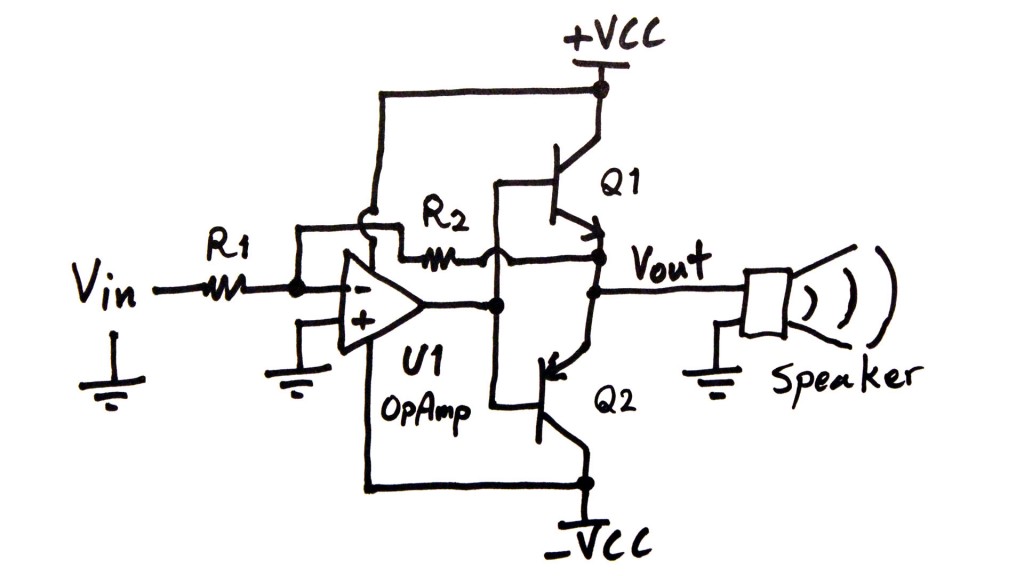Designing an audio power amplifier is much simpler than you think:
The audio amplifier I designed here is to drive the sub woofer speaker I showed, which I used in my other experiment in “The Secret to Levitation (Experiment with Water)”
The schematic of the amplifier is repeated here below:
The parts I used are listed here:
- Q1: D44H11TU from Fairchild, NPN 80V 10A TO-220
- Q2: KSB596YTU from Fairchild, PNP 80V 4A TO-220
- U1: TS912IN from STM, Rail to Rail Dual OpAmp, 2.7 to 16V, 8-DIP
- R2 = 5.6K, R1 = 1K for a gain of -R2/R1 = -5.6 V/V
They call this circuit a class AB amplifier, where there are two output power transistors, one on the high side (Q1) and one on the low side (Q2). Q1 supplies the positive output voltages while Q2 supplies the negative output voltages. So they each share half of the output power if the signal is symmetric around zero.
If we supply the input signal directly to the bases of the transistors, the output signal will be highly distorter due to two reasons:
- Each transistor needs around 0.7V base emitter voltage to turn on. Therefore for any signal smaller than 0.7V amplitude the output remains unchanged and transistors will clip the signal.
- The transistors show non-linear large signal behavior under load and will distort the output voltage.
Therefore I added an Operational Amplifier (OpAmp) to the circuit. What the OpAmp does is to compare the output voltage to the input voltage and generate a special signal at the OpAmp output or the transistor input, which would cause the transistor output to be almost equal to the input signal. Below is the hand drawn waveforms, if you can’t tell!
You can see that the OpAmp output voltage (VOpAmp) jumps when the voltage gets close to where the transistors turn off. Doing this, the OpAmp makes sure that the moment when transistors are both off is very short and this will cause a very negligible glitch at the output that is not noticeable.
Feedback resistors R1 and R2 are used to adjust the circuit gain. The gain here is equal to -R2/R1. I adjusted the gain for my circuit to around 6 V/V because I measured the output amplitude of my cellphone to be around 1V and I wanted a swing that could go as high as the circuit would allow.
The output of the phone is design to drive headphones with around 40 ohm impedance. I usually choose the feedback resistors above 1K Ohm. So the phone will have no problem driving such load.
The transistor outputs can still be slightly distorted, but it will not show at low frequencies, and depending on the speed and drive capability of the OpAmp it might only show at higher frequencies that can be outside the human hearing range anyways.
The circuit is design to work with a positive and negative supply with a common ground. The output voltage will be limited by the supply, and the limiting factor is the output of the OpAmp. So to get the maximum voltage swing, it is better to use a rail-to-rail OpAmp. Also you can always increase the supply voltage.
But beware that if you increase the output level, you are putting more power drop across your transistors. So make sure you do your power calculations and provide enough heat sinking on those transistors to keep them cool enough and avoid damage.
Isn’t it awesome that drill batteries have this extra center contact?! You can use one battery as a dual supply.
You also see in the video how the speaker vibrating at 31Hz seems to be moving very slow. This is the exact same effect as in my previous post, “The Secret to Levitation (Experiment with Water)“. The slow movement is something that is captured by the camera and is not visible to human eye in normal cases.
My next video will continue on a new experiment using the same components, but with very interesting and different results. So stay tuned!


